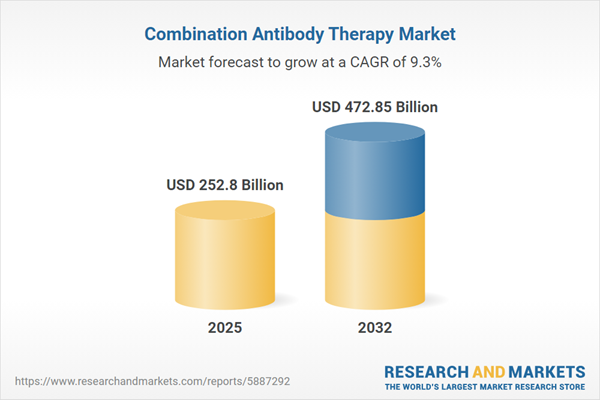Speak directly to the analyst to clarify any post sales queries you may have.
The combination antibody therapy market presents senior executives with timely solutions for addressing clinical complexity, regulatory shifts, and rising demands for resilient healthcare delivery. Early adoption and robust integration of these therapies help organizations remain responsive, sustain innovation, and reinforce competitiveness in an evolving industry landscape.
Market Snapshot: Combination Antibody Therapy Market Performance
The global combination antibody therapy market is experiencing strong momentum, with revenue growth projected from USD 231.55 billion in 2024 to USD 252.80 billion in 2025, reflecting a 9.33% compound annual growth rate (CAGR). By 2032, the market is anticipated to reach USD 472.85 billion. Methodological advances in clinical research, expanded disease applications, and robust uptake by healthcare providers propel this expansion. Stakeholders leverage combination antibody therapies to address resistant treatment pathways and improve clinical outcomes. Flexible operations, evolving regulations, and collaborative business models support sustained advancement and adaptability across diverse healthcare systems worldwide.
Scope & Segmentation: Strategic Overview for Executive Management
- Indications: Spans autoimmune disorders such as multiple sclerosis and rheumatoid arthritis, infectious diseases including COVID-19 and HIV, and multifaceted oncology applications for breast, colorectal, and lung cancers. These areas represent high-need populations where therapeutic gaps persist.
- Product Types: Encompasses antibody drug conjugates, bispecific antibodies, monoclonal antibody combinations, and IgG subclasses. Each category supports the transition to precision medicine and addresses a variety of clinical requirements.
- Therapeutic Approaches: Includes combinations with chemotherapy, CAR-T cells, checkpoint inhibitors, cytokine-based approaches, and targeted agents, allowing organizations to tailor interventions for complex disease mechanisms.
- Treatment Regimens: Covers adjuvant, neoadjuvant, first-line, and second-line protocols, which support flexibility and adaptation in patient management as clinical standards evolve.
- End Users: Addresses needs of hospitals, research organizations, and specialty clinics, each influencing the pace and direction of therapy innovation and expanded access.
- Distribution Channels: Utilizes hospital networks, digital platforms, and retail pharmacies, enhancing supply reliability and enabling effective patient adherence throughout treatment cycles.
- Regions Covered: Encompasses the Americas, EMEA, and Asia-Pacific, highlighting the significance of regulatory differences and market maturity. Countries like the US, Europe, China, India, Japan, and Australia underscore the importance of localized strategies and compliance adaptation.
- Key Companies: Features F. Hoffmann-La Roche Ltd., AbbVie Inc., Johnson & Johnson, Bristol-Myers Squibb Company, Merck & Co., Inc., Amgen Inc., Pfizer Inc., Novartis AG, Sanofi S.A., and AstraZeneca PLC. These leaders drive development pipelines and form strategic alliances to strengthen market presence.
Key Takeaways for Senior Decision-Makers
- Combination antibody therapies enable healthcare systems to tackle treatment-resistant conditions and develop tailored pathways that respond effectively to patient needs.
- Recent regulatory changes are shortening the route to market, allowing organizations to remain agile and compliant in complex and dynamic regulatory environments.
- Integration of digital and data-driven solutions supports personalized care initiatives and facilitates seamless deployment of advanced therapies across care settings.
- Regional expansion, especially in Asia-Pacific, necessitates targeted strategies informed by local regulatory frameworks and healthcare systems.
- Partnerships among pharmaceutical firms, research bodies, and regulators help expedite therapy launches and enhance patient access to innovative options.
- Leveraging technology-driven risk management practices supports operational stability and proactive navigation of shifting market and regulatory conditions.
Tariff Impact: Navigating U.S. Policy and Supply Chains
Recent shifts in U.S. tariffs on imported recombinant proteins are driving organizations to revise their supply chain strategies. Effective approaches include near-shoring operations, building vertical manufacturing capabilities, and strengthening supplier partnerships. These changes help organizations ensure uninterrupted therapy distribution and ongoing compliance with U.S. policy updates.
Methodology & Data Sources
This combination antibody therapy market report synthesizes insights from executive interviews, clinical trial registry analyses, peer-reviewed literature, and confidential proprietary sources. Dedicated expert validation ensures findings are actionable and relevant for executive-level strategy and market positioning.
Why This Combination Antibody Therapy Market Report Matters
- Enables organizations to confidently navigate the complex interplay of clinical, regulatory, and commercial market dynamics.
- Enhances strategic decision-making by strengthening compliance, risk management, and fostering partnerships crucial to long-term market sustainability.
- Offers practical guidance for identifying growth opportunities, building resilience, and securing competitive positioning within rapidly evolving healthcare sectors.
Conclusion
The combination antibody therapy market is redefining key priorities for healthcare leaders. Informed use of market intelligence empowers executives to support innovation and maintain operational strength in the face of continuous industry change.
Additional Product Information:
- Purchase of this report includes 1 year online access with quarterly updates.
- This report can be updated on request. Please contact our Customer Experience team using the Ask a Question widget on our website.
Table of Contents
3. Executive Summary
4. Market Overview
7. Cumulative Impact of Artificial Intelligence 2025
Companies Mentioned
The companies profiled in this Combination Antibody Therapy market report include:- F. Hoffmann-La Roche Ltd.
- AbbVie Inc.
- Johnson & Johnson
- Bristol-Myers Squibb Company
- Merck & Co., Inc.
- Amgen Inc.
- Pfizer Inc.
- Novartis AG
- Sanofi S.A.
- AstraZeneca PLC
Table Information
| Report Attribute | Details |
|---|---|
| No. of Pages | 190 |
| Published | November 2025 |
| Forecast Period | 2025 - 2032 |
| Estimated Market Value ( USD | $ 252.8 Billion |
| Forecasted Market Value ( USD | $ 472.85 Billion |
| Compound Annual Growth Rate | 9.3% |
| Regions Covered | Global |
| No. of Companies Mentioned | 11 |









